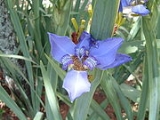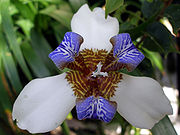
Neomarica
Encyclopedia
Neomarica is a genus
of 16 species of plants in family Iridaceae
, native to tropical regions of western Africa
, and Central
and South America
, with the highest diversity (12 species) in Brazil
. The genus name is derived from the Greek
words neo, meaning "new", and Marica, the Roman nymph.
perennial plant
s that propagate by way of a thick rhizome
and new plantlets that develop from the stem where flowers once emerged. The plants grow erect, and have long slender lanceolate leaves from 30-160 cm long and 1-4 cm broad, depending on the species. They produce very fragrant flowers that last for a short period of time, often only 18 hours.
The flower
s emerge from what appears to be just another leaf, but is really a flower stalk structured to look like the other leaves; they are 5-10 cm diameter, and closely resemble Iris
flowers.
After pollination, the new plantlet appears where the flower emerged and the stalk continues to grow longer. The weight of the growing plantlet causes the stalk to bend toward the ground, allowing the new plantlet to root away from its parent. This is how it obtained the common name of "Walking Iris". The other common name "Apostle Plant" comes from the belief that the plant will not flower until the individual has at least 12 leaves, the number of apostles of Jesus
.

s that are easily cultivated both in garden
s in subtropical and tropical regions, and as houseplant
s in temperate areas.
Genus
In biology, a genus is a low-level taxonomic rank used in the biological classification of living and fossil organisms, which is an example of definition by genus and differentia...
of 16 species of plants in family Iridaceae
Iridaceae
The Iris family or Iridaceae is a family of perennial, herbaceous and bulbous plants included in the monocot order Asparagales, taking its name from the genus Iris. Almost worldwide in distribution and one of the most important families in horticulture, it includes more than 2000 species...
, native to tropical regions of western Africa
Africa
Africa is the world's second largest and second most populous continent, after Asia. At about 30.2 million km² including adjacent islands, it covers 6% of the Earth's total surface area and 20.4% of the total land area...
, and Central
Central America
Central America is the central geographic region of the Americas. It is the southernmost, isthmian portion of the North American continent, which connects with South America on the southeast. When considered part of the unified continental model, it is considered a subcontinent...
and South America
South America
South America is a continent situated in the Western Hemisphere, mostly in the Southern Hemisphere, with a relatively small portion in the Northern Hemisphere. The continent is also considered a subcontinent of the Americas. It is bordered on the west by the Pacific Ocean and on the north and east...
, with the highest diversity (12 species) in Brazil
Brazil
Brazil , officially the Federative Republic of Brazil , is the largest country in South America. It is the world's fifth largest country, both by geographical area and by population with over 192 million people...
. The genus name is derived from the Greek
Greek language
Greek is an independent branch of the Indo-European family of languages. Native to the southern Balkans, it has the longest documented history of any Indo-European language, spanning 34 centuries of written records. Its writing system has been the Greek alphabet for the majority of its history;...
words neo, meaning "new", and Marica, the Roman nymph.
Description
They are herbaceousHerbaceous
A herbaceous plant is a plant that has leaves and stems that die down at the end of the growing season to the soil level. They have no persistent woody stem above ground...
perennial plant
Perennial plant
A perennial plant or simply perennial is a plant that lives for more than two years. The term is often used to differentiate a plant from shorter lived annuals and biennials. The term is sometimes misused by commercial gardeners or horticulturalists to describe only herbaceous perennials...
s that propagate by way of a thick rhizome
Rhizome
In botany and dendrology, a rhizome is a characteristically horizontal stem of a plant that is usually found underground, often sending out roots and shoots from its nodes...
and new plantlets that develop from the stem where flowers once emerged. The plants grow erect, and have long slender lanceolate leaves from 30-160 cm long and 1-4 cm broad, depending on the species. They produce very fragrant flowers that last for a short period of time, often only 18 hours.
The flower
Flower
A flower, sometimes known as a bloom or blossom, is the reproductive structure found in flowering plants . The biological function of a flower is to effect reproduction, usually by providing a mechanism for the union of sperm with eggs...
s emerge from what appears to be just another leaf, but is really a flower stalk structured to look like the other leaves; they are 5-10 cm diameter, and closely resemble Iris
Iris (plant)
Iris is a genus of 260-300species of flowering plants with showy flowers. It takes its name from the Greek word for a rainbow, referring to the wide variety of flower colors found among the many species...
flowers.
After pollination, the new plantlet appears where the flower emerged and the stalk continues to grow longer. The weight of the growing plantlet causes the stalk to bend toward the ground, allowing the new plantlet to root away from its parent. This is how it obtained the common name of "Walking Iris". The other common name "Apostle Plant" comes from the belief that the plant will not flower until the individual has at least 12 leaves, the number of apostles of Jesus
Jesus
Jesus of Nazareth , commonly referred to as Jesus Christ or simply as Jesus or Christ, is the central figure of Christianity...
.
Species
- Neomarica caerulea
- Neomarica capitellata
- Neomarica caulosa
- Neomarica fluminensis
- Neomarica gracilis
- Neomarica imbricata
- Neomarica longifolia
- Neomarica nitida
- Neomarica northiana

- Neomarica paradoxa
- Neomarica portosecurensis
- Neomarica rotundata
- Neomarica rupestris
- Neomarica sabini
- Neomarica silvestris
- Neomarica variegata
Cultivation and uses
Some Neomarica species such as N. northiana, N. longifolia, and N. caerulea are common ornamental plantOrnamental plant
Ornamental plants are plants that are grown for decorative purposes in gardens and landscape design projects, as house plants, for cut flowers and specimen display...
s that are easily cultivated both in garden
Garden
A garden is a planned space, usually outdoors, set aside for the display, cultivation, and enjoyment of plants and other forms of nature. The garden can incorporate both natural and man-made materials. The most common form today is known as a residential garden, but the term garden has...
s in subtropical and tropical regions, and as houseplant
Houseplant
A houseplant is a plant that is grown indoors in places such as residences and offices. Houseplants are commonly grown for decorative purposes, positive psychological effects, or health reasons such as indoor air purification...
s in temperate areas.

